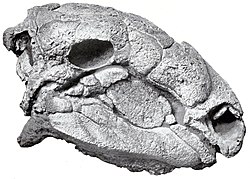Panoplosaurus
|
Panoplosaurus Temporal range: Late Cretaceous, 76 Ma |
|
|---|---|
 |
|
| Holotype skull | |
| Scientific classification | |
| Kingdom: | Animalia |
| Phylum: | Chordata |
| Class: | Reptilia |
| Clade: | Dinosauria |
| Order: | †Ornithischia |
| Clade: | †Eurypoda |
| Suborder: | †Ankylosauria |
| Family: | †Nodosauridae |
| Genus: |
†Panoplosaurus Lambe, 1919 |
| Type species | |
|
†Panoplosaurus mirus Lambe, 1919 |
|
Panoplosaurus (meaning "completely armoured lizard") is a genus of nodosaurid dinosaur. It was one of the last known nodosaurids, living during the Late Cretaceous in what is now North America; fossils have been located in Alberta, Canada.
The first fossil was found in 1917 by Charles M. Sternberg in Quarry 8, near Little Sandhill Creek. The type species Panoplosaurus mirus was named by Lawrence M. Lambe in 1919. The generic name is derived from Greek pan, "completely" and hoplon, "armour". The specific name means "wondrous" in Latin.
This holotype, CMN 2759, was discovered in the Dinosaur Park Formation dating from the late middle Campanian, 76 million years ago. It consists of the complete skull with lower jaws, the cervical vertebrae, some dorsal vertebrae and some ribs. Part of the bony armour scutes or osteoderms were preserved. Later two more large specimens were found, again containing skulls but also providing some information about the shoulder girdle and front limbs: ROM 1215 and RTMP 83.25.2.
Panoplosaurus was 5 to 7 metres (16 to 23 ft) long, around 2 metres (6.6 ft) tall, and had an estimated weight of 1.5–1.6 tonnes (1.7–1.8 short tons). It was heavily armoured, even by the standards of other nodosaurs, probably with traverse bands of studded plates covering its back and tail, although the tail likely lacked the club found in ankylosaurids. Larger paired ovals of bony armour covered the neck, shoulders and front limbs. These ovals were keeled, possessing a prominent curved ridge on the outer surface. Spikes on the shoulder, that some other nodosaurids featured, were absent. The armour on the head was fused into a compact helmet-like shield; these plates had a lumpy surface. Also bony cheek scutes were present.
...
Wikipedia
